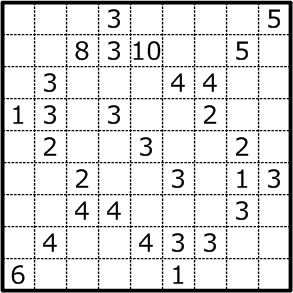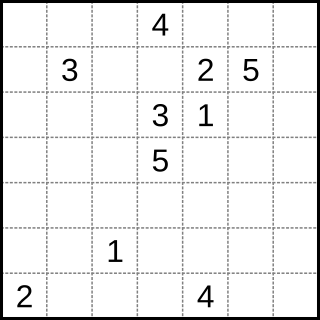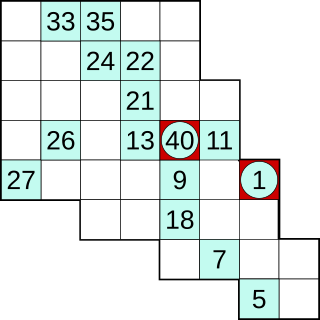
A crossword is a word puzzle that usually takes the form of a square or a rectangular grid of white- and black-shaded squares. The goal is to fill the white squares with letters, forming words or phrases that cross each other, by solving clues which lead to the answers. In languages that are written left-to-right, the answer words and phrases are placed in the grid from left to right ("across") and from top to bottom ("down"). The shaded squares are used to separate the words or phrases.
A cryptic crossword is a crossword puzzle in which each clue is a word puzzle. Cryptic crosswords are particularly popular in the United Kingdom, where they originated, Ireland, Israel, the Netherlands, and in several Commonwealth nations, including Australia, Canada, India, Kenya, Malta, New Zealand, and South Africa. Compilers of cryptic crosswords are commonly called "setters" in the UK and "constructors" in the US. Particularly in the UK, a distinction may be made between cryptics and "quick" crosswords, and sometimes two sets of clues are given for a single puzzle grid.
A logic puzzle is a puzzle deriving from the mathematical field of deduction.

Nonograms, also known as Hanjie, Paint by Numbers, Picross, Griddlers, and Pic-a-Pix, and by various other names, are picture logic puzzles in which cells in a grid must be colored or left blank according to numbers at the side of the grid to reveal a hidden pixel art-like picture. In this puzzle type, the numbers are a form of discrete tomography that measures how many unbroken lines of filled-in squares there are in any given row or column. For example, a clue of "4 8 3" would mean there are sets of four, eight, and three filled squares, in that order, with at least one blank square between successive sets.

Kakuro or Kakkuro or Kakoro is a kind of logic puzzle that is often referred to as a mathematical transliteration of the crossword. Kakuro puzzles are regular features in many math-and-logic puzzle publications across the world. In 1966, Canadian Jacob E. Funk, an employee of Dell Magazines, came up with the original English name Cross Sums and other names such as Cross Addition have also been used, but the Japanese name Kakuro, abbreviation of Japanese kasan kurosu, seems to have gained general acceptance and the puzzles appear to be titled this way now in most publications. The popularity of Kakuro in Japan is immense, second only to Sudoku among Nikoli's famed logic-puzzle offerings.

Sudoku is a logic-based, combinatorial number-placement puzzle. In classic Sudoku, the objective is to fill a 9 × 9 grid with digits so that each column, each row, and each of the nine 3 × 3 subgrids that compose the grid contain all of the digits from 1 to 9. The puzzle setter provides a partially completed grid, which for a well-posed puzzle has a single solution.

The Battleship puzzle is a logic puzzle based on the Battleship guessing game. It and its variants have appeared in several puzzle contests, including the World Puzzle Championship, and puzzle magazines, such as Games magazine.

Fillomino (フィルオミノ) is a type of logic puzzle published by many publishers. Other published titles for the puzzle include Allied Occupation.
Games World of Puzzles is an American games and puzzle magazine. Originally the merger of two other puzzle magazines spun off from its parent publication Games magazine in the early 1990s, Games World of Puzzles was reunited with Games in October 2014.

Mathematics can be used to study Sudoku puzzles to answer questions such as "How many filled Sudoku grids are there?", "What is the minimal number of clues in a valid puzzle?" and "In what ways can Sudoku grids be symmetric?" through the use of combinatorics and group theory.

This is a glossary of Sudoku terms and jargon. It is organized thematically, with links to references and example usage provided as ([1]). Sudoku with a 9×9 grid is assumed, unless otherwise noted.

Numberlink is a type of logic puzzle involving finding paths to connect numbers in a grid.
The New York Times crossword puzzle is a daily American-style crossword puzzle published in The New York Times, online on the newspaper's website, syndicated to more than 300 other newspapers and journals, and on mobile apps.

Gokigen Naname, also known as Slant, is a binary-determination logic puzzle published by Nikoli.

A standard Sudoku contains 81 cells, in a 9×9 grid, and has 9 boxes, each box being the intersection of the first, middle, or last 3 rows, and the first, middle, or last 3 columns. Each cell may contain a number from one to nine, and each number can only occur once in each row, column, and box. A Sudoku starts with some cells containing numbers (clues), and the goal is to solve the remaining cells. Proper Sudokus have one solution. Players and investigators use a wide range of computer algorithms to solve Sudokus, study their properties, and make new puzzles, including Sudokus with interesting symmetries and other properties.

Derrick Somerset Macnutt (1902–1971) was a British crossword compiler who provided crosswords for The Observer newspaper under the pseudonym Ximenes. His main oeuvre was blocked-grid and "specialty" puzzles. Even though he only provided conventional blocked puzzles once a week for the Observer Everyman series for about two years his strong views on clueing, expressed in his 1966 book, have been a source of debate in the cryptic crossword world ever since.

The Eternity II puzzle is an edge-matching puzzle launched on 28 July 2007. It was developed by Christopher Monckton and marketed and copyrighted by TOMY UK Ltd as a successor to the original Eternity puzzle. The puzzle was part of a competition in which a $2 million prize was offered for the first complete solution. The competition ended at noon on 31 December 2010, with no solution being found.

Hidato, also known as "Hidoku", is a logic puzzle game invented by Dr. Gyora M. Benedek, an Israeli mathematician. The goal of Hidato is to fill the grid with consecutive numbers that connect horizontally, vertically, or diagonally. The name Hidato is a registered trademark of Doo-Bee Toys and Games LTD, a company co-founded by Benedek himself. Some publishers use different names for this puzzle such as Number Snake, Snakepit, Jadium or Numbrix.

Str8ts is a logic-based number-placement puzzle, invented by Jeff Widderich in 2008. It is distinct from, but shares some properties and rules with Sudoku. The name is derived from the poker straight. The puzzle is published in a number of newspapers internationally, in two book collections, and in downloadable apps. It was featured on the Canadian television show Dragons' Den on November 24, 2010.

Exit is an American game show on Syfy that premiered on June 4, 2013.














